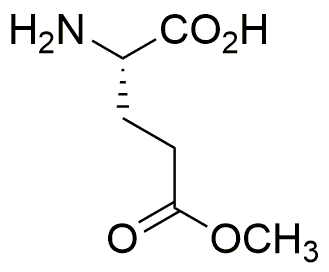L-Glutamic acid g-methyl ester is widely utilized in research focused on:
- Food Industry: It serves as a flavor enhancer, providing umami taste in various food products, making them more appealing to consumers.
- Pharmaceuticals: This compound is used in drug formulations to improve solubility and bioavailability, enhancing therapeutic effects.
- Biotechnology: It plays a role in cell culture media, supporting the growth of various cell lines, which is crucial for vaccine production and research.
- Agriculture: As a plant growth regulator, it promotes root development and overall plant health, leading to improved crop yields.
- Neuroscience: Its derivatives are studied for neuroprotective properties, potentially aiding in the treatment of neurodegenerative diseases.
General Information
Properties
Safety and Regulations
Applications
L-Glutamic acid g-methyl ester is widely utilized in research focused on:
- Food Industry: It serves as a flavor enhancer, providing umami taste in various food products, making them more appealing to consumers.
- Pharmaceuticals: This compound is used in drug formulations to improve solubility and bioavailability, enhancing therapeutic effects.
- Biotechnology: It plays a role in cell culture media, supporting the growth of various cell lines, which is crucial for vaccine production and research.
- Agriculture: As a plant growth regulator, it promotes root development and overall plant health, leading to improved crop yields.
- Neuroscience: Its derivatives are studied for neuroprotective properties, potentially aiding in the treatment of neurodegenerative diseases.
Documents
Safety Data Sheets (SDS)
The SDS provides comprehensive safety information on handling, storage, and disposal of the product.
Product Specification (PS)
The PS provides a comprehensive breakdown of the product’s properties, including chemical composition, physical state, purity, and storage requirements. It also details acceptable quality ranges and the product's intended applications.
Certificates of Analysis (COA)
Search for Certificates of Analysis (COA) by entering the products Lot Number. Lot and Batch Numbers can be found on a product’s label following the words ‘Lot’ or ‘Batch’.
*Catalog Number
*Lot Number
Certificates Of Origin (COO)
This COO confirms the country where the product was manufactured, and also details the materials and components used in it and whether it is derived from natural, synthetic, or other specific sources. This certificate may be required for customs, trade, and regulatory compliance.
*Catalog Number
*Lot Number
Safety Data Sheets (SDS)
The SDS provides comprehensive safety information on handling, storage, and disposal of the product.
DownloadProduct Specification (PS)
The PS provides a comprehensive breakdown of the product’s properties, including chemical composition, physical state, purity, and storage requirements. It also details acceptable quality ranges and the product's intended applications.
DownloadCertificates of Analysis (COA)
Search for Certificates of Analysis (COA) by entering the products Lot Number. Lot and Batch Numbers can be found on a product’s label following the words ‘Lot’ or ‘Batch’.
*Catalog Number
*Lot Number
Certificates Of Origin (COO)
This COO confirms the country where the product was manufactured, and also details the materials and components used in it and whether it is derived from natural, synthetic, or other specific sources. This certificate may be required for customs, trade, and regulatory compliance.


